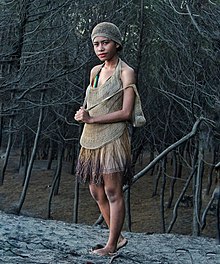

Bunani Mee | |
|---|---|

Native Mee women wearing traditional clothing
| |
| Total population | |
| 157,000 | |
| Regions with significant populations | |
| Languages | |
| Ekagi language, Indonesian language | |
| Religion | |
| Christianity (95%), Islam (2%), other ethnic religions (3%)[1] |
The Mee (also Bunani Mee, Ekari, Ekagi, Kapauku) are a people in the Wissel Lakes area of Central Papua, Indonesia.[2] They speak the Ekagi language.
In the 1970s, an investigation was conducted by Indonesian physicians concerned about the high rates of Ekari people hospitalized for burns. The study revealed many Ekari people were suffering from neurocysticercosis, caused by the pork tapeworm, Taenia solium, which had been previously unseen in Papua New Guinea. As a result, many had been suffering seizures while near fires, injuring themselves in the process. Pigs infected with the tapeworms had been introduced to the island previously by the Indonesian unknowingly.[3] Though based on modern genetic study, tapeworms in Papua are the oldest among Indonesian haplotypes. They diverged from lineages in Bali at minimum 25,000 years BP, hence unlikely to be recent introduction.[4]
|
| |
|---|---|
| Sumatra |
|
| Java |
|
| Kalimantan |
|
| Sulawesi |
|
| Papua |
|
| Lesser Sunda Islands |
|
| Maluku Islands |
|
| Non-indigenous |
|
This Indonesia-related article is a stub. You can help Wikipedia by expanding it. |
This article about an ethnic group in Asia is a stub. You can help Wikipedia by expanding it. |